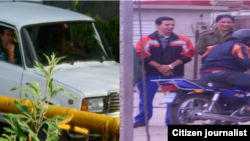For citizen reporters in Cuba the few possibilities of connecting to the Internet and the knowledge needed to effectively use a cell phone have been staples to exposing their reality in different ways.
Citizen journalists have used cell phones to post pictures, MMS video and text messages to Twitter. Media and communications have also been sent to email accounts.
Reports range from a simple look at the streets of any city, to a heated protest in a public square such as the one that occurred in Havana, in which dozens of “cuentapropistas,” or small business owners broke out in protest and were suppressed by local authorities. The work of a cadre of anonymous people was responsible for capturing the images and made available to our editorial staff. It showed the details of a protest that would have otherwise gone unnoticed.
Among the video reports received via MMS was one filmed from a phone in Santiago de Cuba, in a town called Mella, depicting the transportation crisis in that area. There was one of a young painter working on his latest piece and one of the two Ladies in White preparing a King’s Day party for children in Santiago de Cuba.
SMS texting has proven to be yet another way to report from a cell phone. Citizens are able to air complaints and report events that happen in their city. These have been essential for situations that should be reported and that require attention.
Social networking sites, such as Twitter and Facebook have been used to disseminate information and keep gaining users across the country.
We have also received reports from dozens of journalists from various regions of Cuba.
With the images released on Twitter by Lazaro Yuri Valle in the capital, Inalkis Rodriguez in Camagüey, and Ivan Hernandez, Felix Navarro and Leticia Ramos Smithy in Matanzas, an extensive gallery has been made possible.
On his Facebook page, Manuel Robles posted pictures of when he visited the town of Candelaria on February 2 during the local festivities.
Other activists have preferred to use email to send us their stories and opinions from various parts of the island.
The network of communicators, directed by Marta Beatriz Roque, has maintained a steady stream of publishable images of daily life both in the provinces and in the capital.
Citizen journalists have used cell phones to post pictures, MMS video and text messages to Twitter. Media and communications have also been sent to email accounts.
Reports range from a simple look at the streets of any city, to a heated protest in a public square such as the one that occurred in Havana, in which dozens of “cuentapropistas,” or small business owners broke out in protest and were suppressed by local authorities. The work of a cadre of anonymous people was responsible for capturing the images and made available to our editorial staff. It showed the details of a protest that would have otherwise gone unnoticed.
Among the video reports received via MMS was one filmed from a phone in Santiago de Cuba, in a town called Mella, depicting the transportation crisis in that area. There was one of a young painter working on his latest piece and one of the two Ladies in White preparing a King’s Day party for children in Santiago de Cuba.
SMS texting has proven to be yet another way to report from a cell phone. Citizens are able to air complaints and report events that happen in their city. These have been essential for situations that should be reported and that require attention.
Social networking sites, such as Twitter and Facebook have been used to disseminate information and keep gaining users across the country.
We have also received reports from dozens of journalists from various regions of Cuba.
With the images released on Twitter by Lazaro Yuri Valle in the capital, Inalkis Rodriguez in Camagüey, and Ivan Hernandez, Felix Navarro and Leticia Ramos Smithy in Matanzas, an extensive gallery has been made possible.
On his Facebook page, Manuel Robles posted pictures of when he visited the town of Candelaria on February 2 during the local festivities.
Other activists have preferred to use email to send us their stories and opinions from various parts of the island.
The network of communicators, directed by Marta Beatriz Roque, has maintained a steady stream of publishable images of daily life both in the provinces and in the capital.




